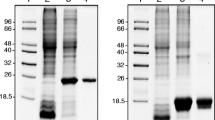Summary
InEscherichia coli, the superoxide dismutase genes (sodA andsodB) sense the availability of Fe through the action of thefur locus [E. C. Niederhoffer, C. M. Naranjo, K. L. Bradley, J. A. Fee (1990) Control ofEscherichia coli superoxide dismutases (sodA andsodB) genes by the ferric uptake regulation (fur) locus,J. Bacteriol. 172, 1930–1938]. Previous work from other laboratories has shown that a variety of metal chelators and of redox-active aromatic compounds can dramatically induce expression ofsodA. Here we show that non-redox-active, non-metal-chelating aromatic compounds also enhance expression of a chromosomalsodA gene fusion and that these effects are strongly modulated by the Fur phenotype (Fur±) and by the availability of iron in the culture medium. The compounds studied were ethidium bromide, hemin, 2,2′-bipyridine, 1,10-phenantroline, 4,7-phenantroline, rhodamine B1, rhodamine 6G, and, for comparison to previous studies, Paraquat.
Similar content being viewed by others
Abbreviations
- DTPA:
-
diethylenetriaminepentaacetic acid
- Paraquat:
-
N,N′-dimethyl-1,1-bipyridene
- bpy:
-
2,2′-bipyridine
- phen:
-
1,10-phenanthroline
- 4,7-phen:
-
4,7-phenanthroline
References
Bagg A, Neifands JB (1987) Molecular mechanism of regulation of siderophore-mediated iron assimilation. Microbiol Rev 51:509–518
Chen LB, Summerhayes IC, Johnson LV, Walsh ML, Bernal SD, Lampidis TJ (1982) Probing mitochondria in living cells with rhodamine 123. Cold Spring Harbor Symp Quant Biol 46:141–155
Greenberg JT, Monarch P, Chou JH, Josephy PD, Demple B (1990) Positive control of a global antioxidant defense regulon activated by sup eroxide-generating agents inEscherichia coli. Proc Natl Acad Sci USA 87:6181–6185
Gregory EM, Fridovich I (1973) Induction of superoxide dismutase by molecular oxygen. J Bacteriol 114:543–548
Hassan HM (1989) Microbial superoxide dismutases. Adv Genet 26:65–97
Hassan HM, Fridovich I (1977) Regulation of the synthesis of superoxide dismutase inEscherichia coli. Induction by methylviologen. J Biol Chem 252:7667–7672
Hassan HM, Fridovich I (1979) Intracellular production of superoxide radical and of hydrogen peroxide by redox-active compounds. Arch Biochem Biophys 196:385–395
Jones RW, Garland PB (1977) Sites and specificity of the reaction of bipyridylium compounds with anaerobic respiratory enzymes ofEscherichia coli. Biochem J 164:199–211
Kao SM, Hassan HM (1985) Biochemical characterization of a Paraquat-tolerant mutant ofEscherichia coli. J Biol Chem 260:10478–10481
Kogoma T, Farr SB, Joyce KM, Natvig DO (1988) Isolation of gene fusions inducible by oxidative stressEscherichia coli. Proc Natl Acad Sci USA 85:4799–4803
Minton KW, Tabor H, Tabor CW (1990) Paraquat toxicity is increased inEscherichia coli defective in the synthesis of polyamines. Proc Natl Acad Sci USA 87:2851–2855
Moody CS, Hassan HM (1984) Anaerobic biosynthesis of the manganese-containing superoxide dismutase inEscherichia coli. J Biol Chem 259:12821–12825
Niederhoffer EC, Naranjo CM, Bradley KL, Fee JA (1990) Control ofEscherichia coli superoxide dismutase (sodA andsodB) genes by the ferric uptake regulation (fur) locus. J Bacteriol 172:1930–1938
Nikaido H, Vaara M (1985) Molecular basis of bacterial outer membrane permeability. Microbiol Rev 49:1–32
Sigman DS, Chen C-B (1990) Chemical nucleases: new reagents in molecular biology. Annu Rev Biochem 59:207–236
Simons RS, Jackett PS, Carroll MEW, Lowrie DB (1976) Superoxide independence of Paraquat toxicity inEscherichia coli. Toxicol Appl Pharmacol 37:271–280
Tardat B, Touati D (1990) Two global regulators repress the anaerobic expression of MnSOD inE. coli: Fur (ferric uptake regulation) and Arc (aerobic respiration control). EMBO J, in the press
Thresher RJ, Griffith JD (1990) Intercalators promote the binding of RecA to double-stranded DNA. Proc Natl Acad Sci USA 87:5056–5060
Touati D (1988a) Molecular genetics of superoxide dismutases. Free Radical Biol Med 5:393–402
Touati D (1988b) Transcriptional and posttranscriptional regulation of manganese superoxide dismutase biosynthesis inEscherichia coli, studied with operon and protein fusions. J Bacteriol 170:2511–2520
Tsaneva IR, Weiss B (1990)soxR, a locus governing a superoxide response regulon inEscherichia coli K12. J Bacteriol 172:4197–4205
Author information
Authors and Affiliations
Rights and permissions
About this article
Cite this article
Niederhoffer, E.C., Fee, J.A. Novel effect of aromatic compounds on the iron-dependent expression of theEscherichia coli K12 manganese superoxide dismutase (sodA) gene. Biol Metals 3, 237–241 (1990). https://doi.org/10.1007/BF01140586
Received:
Issue Date:
DOI: https://doi.org/10.1007/BF01140586




